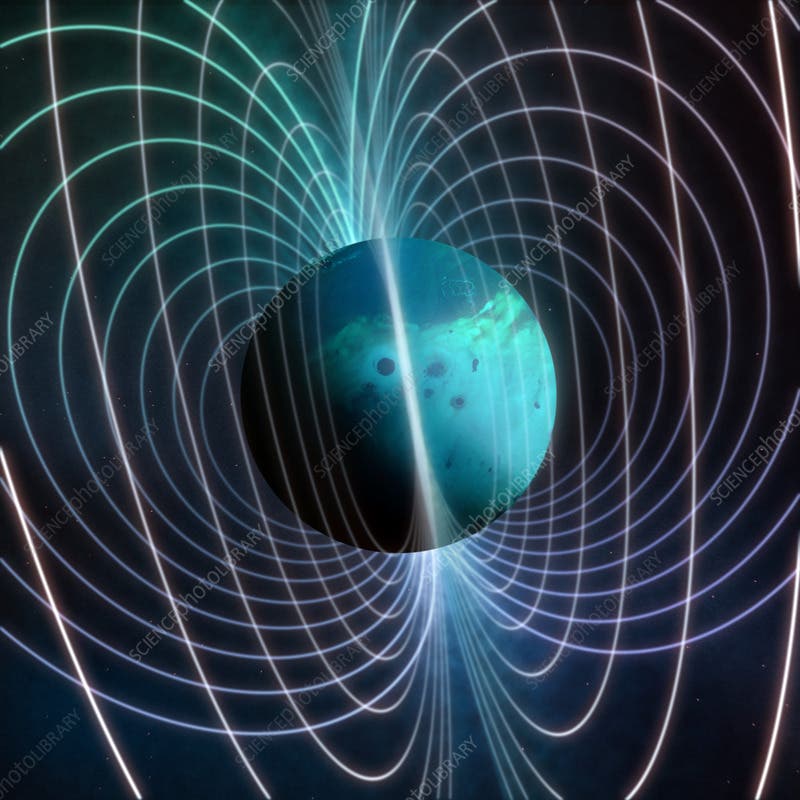Researchers solve the mystery of Uranus and Neptune’s Magnetic Fields
New models reveal the layered interiors of Uranus and Neptune, explaining their chaotic magnetic fields and planetary composition.

New research unveils that Uranus and Neptune’s magnetic fields stem from immiscible interior layers, reshaping our understanding of ice giants. (CREDIT: Adam Makarenko / Science Photo Library)
Beneath the serene, bluish atmospheres of Uranus and Neptune lies an intricate story of planetary interiors. These enigmatic ice giants, shrouded in hydrogen and helium, harbor dynamic processes that challenge conventional planetary science.
Recent breakthroughs in computational modeling have unveiled a new understanding of their layered internal structures, providing insights into their peculiar magnetic fields and composition.
A Puzzle of Magnetic Fields
When Voyager 2 visited Uranus and Neptune in the late 1980s, it uncovered surprising magnetic anomalies. Unlike Earth's dipolar magnetic field, which is created by convection in its liquid outer iron core, the ice giants exhibited chaotic, nondipolar magnetic fields. This disorganization suggested a lack of deep convective layers typically required to generate a global dipole magnetic field.
Planetary scientists long suspected that Uranus and Neptune possess stratified interiors where materials don’t mix freely, preventing large-scale convection. However, the precise nature of these layers remained elusive for decades.
Burkhard Militzer, a planetary scientist at UC Berkeley, tackled the mystery using advanced computer simulations. By modeling the interactions of elements like carbon, nitrogen, hydrogen, and oxygen under the extreme pressures and temperatures of the ice giants’ interiors, his team achieved a breakthrough. They discovered that the planets' interiors naturally separate into two immiscible layers—much like oil and water.
In the upper mantle, a fluid rich in water dominates, while below, a highly compressed mixture of methane (CH₄) and ammonia (NH₃) forms a dense, hydrogen-depleted layer.
At increasing depths, this mixture transforms into a polymeric carbon-nitrogen-hydrogen (C-N-H) fluid, creating a stable, stratified layer incapable of convection. Above this, the water-rich layer remains convective and electrically conductive, generating the disorganized magnetic fields observed by Voyager 2.
Related Stories
Militzer's models drew on the Concentric MacLaurin Spheroid method, a computational tool that simulates planetary interiors by matching observed gravity and magnetic field data. His findings suggest that Uranus' atmosphere, extending about 3,000 miles, overlays a 5,000-mile-thick water-rich layer.
Beneath this lies a hydrocarbon-rich layer of similar thickness, capped by a rocky core roughly the size of Mercury. Neptune, slightly more massive but smaller in diameter, exhibits a thinner atmosphere and layers of comparable composition, though its core is slightly larger, akin to Mars.
These results align with gravity measurements recorded during Voyager 2's flybys, providing a cohesive explanation for the planets' magnetic fields and internal structures.
From Diamond Rain to Superionic Water
Previously, theories about the ice giants’ interiors included exotic ideas such as diamond rain or superionic water—an electrically conductive phase of water thought to exist under extreme conditions. Militzer’s model challenges these concepts, instead attributing the planets' unique magnetic fields to the stratification of water-rich and hydrocarbon-rich layers.
“This separation into two distinct layers explains why Uranus and Neptune have fields so different from Earth, Jupiter, or Saturn,” Militzer explained. “It’s like oil and water—except here, the heavier hydrocarbon layer sinks, while the lighter water-rich layer rises and convects.”
The discoveries on Uranus and Neptune have implications far beyond the solar system. Many exoplanets identified to date fall into the "sub-Neptune" category, similar in size and composition to these ice giants. If other star systems share elemental compositions with ours, their ice giants may also exhibit similarly layered interiors.
Validating this layered model requires experimental and observational efforts. Laboratory experiments replicating the extreme pressures and temperatures within the ice giants could confirm whether similar stratification occurs in fluids reflecting the protosolar system’s elemental proportions.
Additionally, proposed missions to Uranus, such as those by NASA, could employ Doppler imaging to analyze the planet’s vibrations. A layered interior would exhibit different vibrational frequencies compared to a convective one.
Militzer plans to refine his computational models to predict these vibrational differences, further bridging the gap between theoretical simulations and observable phenomena.
Uranus and Neptune’s layered interiors reshape our understanding of ice giants and their place in planetary science. These findings highlight the importance of advanced computational tools and interdisciplinary approaches in unraveling the complexities of distant worlds.
With future missions and experiments on the horizon, the secrets of these enigmatic planets may soon be fully revealed.
Note: Materials provided above by The Brighter Side of News. Content may be edited for style and length.
Like these kind of feel good stories? Get The Brighter Side of News' newsletter.
Joseph Shavit
Head Science News Writer | Communicating Innovation & Discovery
Based in Los Angeles, Joseph Shavit is an accomplished science journalist, head science news writer and co-founder at The Brighter Side of News, where he translates cutting-edge discoveries into compelling stories for a broad audience. With a strong background spanning science, business, product management, media leadership, and entrepreneurship, Joseph brings a unique perspective to science communication. His expertise allows him to uncover the intersection of technological advancements and market potential, shedding light on how groundbreaking research evolves into transformative products and industries.



